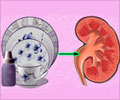Scientists suspect that the insecticide cyromazine may be responsible for the presence of melamine, a toxic constituent of plastics and other materials, in infant formulas.
Scientists suspect that the insecticide cyromazine may be responsible for the presence of melamine, a toxic constituent of plastics and other materials, in infant formulas purchased from stores in Canada.
In a report published in the online edition of the Journal of Agricultural and Food Chemistry, Sheryl Tittlemier and her colleagues have pointed out that it is legal to use cyromazine on food crops and animal forage, and that melamine is one of its breakdown products."In all instances in which melamine was detected, concentrations observed were below the standard of 0.5 micrograms per gram set by Health Canada for infant formula," Science News quoted the researchers as noting.
Tittlemier says that the melamine her team found did not seem to have come from packaging because when they tested the material lining the can, from which the most tainted formula had come, they found no melamine.
Furthermore, the pesticide's manufacturer has published data showing that when goats had been dosed with a radioactively labeled form of the insecticide, five to nine percent of the residues turned up as radiolabeled melamine in the milk.
"It appears plausible that milk from cattle exposed to cyromazine may contain melamine," said Tittlemier and her colleagues, adding that it may help explain how the chemical could end up in milk-based infant formula.
Source-ANI
LIN













